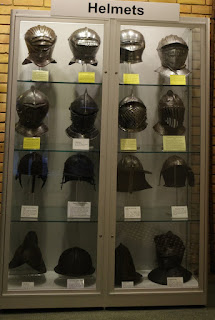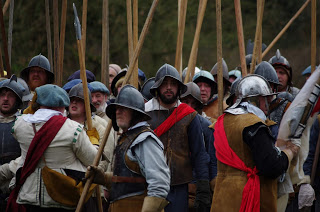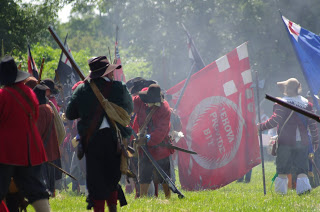Houses of Interest: Buckinghamshire
Considering Buckinghamshire lay between the King at Oxford, and Parliament in London, the county was surprisingly quiet during the Civil Wars with no major conflicts taking place.
Boarstall Tower was garrisoned for the King as part of Oxford's outer defences. When nearby Brill fell to Parliament the garrison fled, and the house was occupied by John Hampden. Hampden's men left in 1644 and the house was retaken for the King by Colonel Henry Gage. Gage's assault launched a heavy bombardmnent of the house, and the resident Lady Dynham, was forced to flee the house in disguise. Fairfax led an unsuccessful assault on the house in May 1645; he would return on the 10th June 1646, taking the house after a siege lasting 18 hours.
 |
| Boarstall Tower |
Boarstall Tower is cared for by the National Trust, and has limited opening hours.
 |
| All Saints, Brill |
All Saints Church in Brill is believed to have the remains of Royalist earthwork defences to the north of the churchyard.
Brill is also believed to be the inspiration for Tolkien's village of Bree.
There seems to be a number of 'Civil War sites' with a Tolkien connection, this is the third that I can think of that have appeared in the ECWtravelogue.
Claydon House was the ancestral home of the Verney family; the Church of All Saints, adjacent to the house, contains a memorial to Sir Edmund Verney who fell at Edgehill whilst holding the King's standard.
According to Verney family history, his body was never identified, except for his severed hand, found still grasping the standard. Unfortunately this story does not appear until 1892, so once again we see Victorian romanticism clouding history.
 |
| The Verney memorial; Sir Edmund is top left |
The current Claydon House dates from the C18th and is cared for by the National Trust; Claydon has a C17th doublet reputedly worn at Charles I's court in its collection.
Our next entry concerns Aylesbury and a battle that may, or may not, have taken place. The First Edition Ordnance Survey sheet of 1884, the area north-west of Holman’s Bridge is marked as “Site of the Battle of Aylesbury, 1642. Human Remains found A.D. 1818”. But did the battle take place? Our contemporary evidence appears in a 1642 pro-Parliament pamphlet Good and Joyful News out of Buckinghamshire.
It reports that a week after the battle of Edgehill Prince Rupert’s forces “…sought to refresh themselves in the…County of Buckingham”, and marched towards Aylesbury. The Royalist army, numbering some 10000 cavalry and infantry, entered the town at 6am, unopposed. There they remained “in indifferent peaceable disposition” until Rupert’s scouts reported the approach of a Parliamentary force believed to be 6000 strong. The pamphlet then describes how Rupert leads charges during the battle.
But there are considerable problems. Rupert wasn't in Aylesbury on the 1st November 1642, his own diaries place him in Abingdon. The numbers of men involved seem to be exaggerated when we consider the numbers of men in the area itself, Parliament's force was claimed to be 1500 strong. The site of Holman's Bridge has no archaeological evidence for the encounter, other than the bodies found in 1818. It is argued that these burials may be from a Saxon burial site. It is now believed that if the encounter did take place, it was no more than a minor skirmish.
What's there today?
 |
| St. Mary's Church |
The bodies discovered in 1818 were reburied at St. Mary's Church in Hardwick, where there is a memorial.
 |
| The memorial stone |
The believed site of the battle, and where the bodies were discovered is Holman's Bridge.
 |
| south of the bridge |
 |
| Holman's Bridge |
The deserted medieval village of Quarrendon Leas to the west of Holman's Bridge has the remains of some Civil War earthwork defences. Good luck trying to work out where they are in the myriad of ghostly traces of the village. Park close to the Berryfields Skate Park.
 |
| north of the bridge, looking towards Quarrendon Leas |
John Hampden is remembered in Aylesbury itself with a statue on Market Square opposite HSBC Bank.
Discover Bucks Museum has a few items connected to Great Hampden House
 |
Victorian fancy dress |
 |
| funerary helmet 1643, Great Hampden |
 |
| Chenies Manor House |
Chenies Manor House was garrisoned by Hampden's greencoats. the House's medieval undercroft might have been used as a prison as there is some Civil War era graffiti. The house is open to visitors on Mondays and Tuesday for guided tours.
One military encounter that definitely took place within the county was at Newport Pagnell, Royalist forces taking the town on the 6th October 1643 and “forced the inhabitants to come in and intrench it and draw the river about it the better to strengthen and fortifie it …”
Major General Skippon was sent to reclaim the town, taking it on October 27th. The fortifications were enhanced and the town garrisoned as abase to raid Royalist Oxford. It was here that Oliver Cromwell (junior) died of typhoid fever while serving as an officer.
What's there today?
There are the very feint remains of a diamond shaped gun battery earthwork in the churchyard of St Peter & St Paul's Church. The battery defended Tickford Bridge. The raised banks in the adjacent Ousebank Gardens are believed to be the remains of a bastion earthwork.
Olney was an outpost of the Newport Pagnell garrison. On the 4th November 1643 a Royalist force marched on Olney, with the intention of assaulting the garrison at Newport Pagnell. The Parliamentarian defenders retreated to Olney Bridge where they made a stand. After a fierce skirmish the Royalist forces withdrew under the belief that a large Parliamentarian force was approaching. A monument to the battle is located on Bridge Street.
Pitstone Windmill, near Ivinghoe most probably dates from the early C17th. A date on one of the timbers declares 1627. Dendrochronology has some timbers felled in the 1590s. Regardless, it is almost certainly the oldest post mill in the country, and will have born witness to the events of the Civil Wars. A fine example for modellers to copy methinks... Alas the rain was of Biblical proportions on the day I popped by, not really a day for getting out of the car, even less so taking photographs. Now cared for by the National Trust, the windmill has very limited opening during the summer months.
All Saints Church, The Green, Brill HP18 9RT
Claydon House and Church of All Saints, Middle Claydon MK18 2EY
Holman's Bridge, Buckingham Road HP20 2BJ
Quarrendon Leas, Martin Dalby Way HP19 9DE
John Hampden statue, Market Square HP20 1TW
Discover Bucks Museum, Church Street HP20 2QP


















Comments
Post a Comment